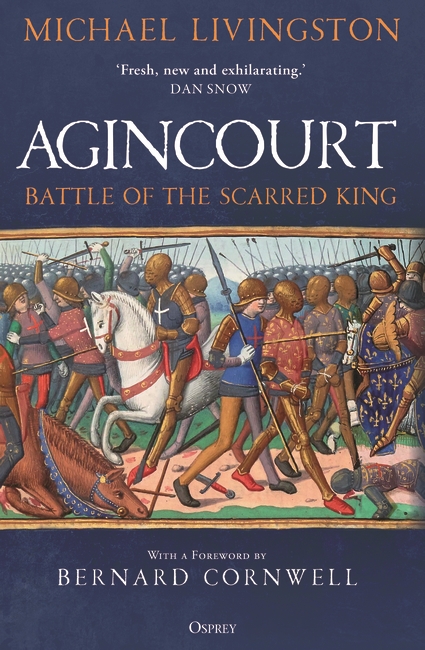
Writing a book on Agincourt presents a number of challenges.
Foremost among them, I think, is whether one should be writing a book on the battle at all. I have shelves of Agincourt books in my library. In doing research for the book, I loaded up with piles more. To commit to writing 100,000 words on the fight – to turn 1,000 books on Agincourt into 1,001 – one better have something useful to add.
With relief, I can say that if I was confident I had a new take on the battle going into the process, I’m even more confident about it now that Agincourt: Battle of the Scarred King is done. So many things I long believed about this extraordinary engagement – things we all believed about it – have been thoroughly revised in this book. The campaign. The plan. The engagement. Oh, the English are still very much the winners in the final analysis, but I bring a different lens to almost everything that adds up to that remarkable result.
So, ‘is it worth it’ was both a challenge that I knew I would face going into the process and one that I knew I would meet early on.
Other challenges, though, weren’t anything I was prepared for when I set out to write the book.
Like where to start it.
Beginnings are important to any piece of writing. I had to think for some time about exactly how best to start this blog, for instance. Obviously, I needed to tell you what I’d be talking about, but I needed to do it in a way that was interesting or intriguing. I needed to ‘hook’ you, as we often call it. I also needed to figure out a way to slip the title of my book up front somewhere. I didn’t want to put it exactly at the top, because this isn’t really an ad for the book. But I nevertheless wanted it close to the top, since after you read this I really do want you to go and buy a copy of Agincourt: Battle of the Scarred King (and that’s mention number two, you see).
The thing is, deciding how to begin my new book on Agincourt was enormously more complicated. I had the same questions of how to hook the reader at the beginning, but I also had historical questions – to some degree, philosophical questions – about where to begin the story.
Because what is the story?
Agincourt itself is a singular moment in time: the desperate, remarkable hours on 25 October 1415 during which Henry V trounced a French army against enormous odds. A story of the battle could tell only the story of those hours themselves and be a story of Agincourt. Doing it this way crossed my mind. But I knew I couldn’t disentangle the reality of what happened on 25 October from what the two armies had experienced in the days leading up to it.
So another beginning might have been the departure of the English army from the ruined walls of Harfleur on 8 October. At that point, Henry thought he could march north to Calais in eight days, entirely uncontested. The fact that the French forces closed in on him and instead forced him into an exceedingly longer and more desperate march plays a massive part in why the fields of northern France bore witness to the contest of life and death that is Agincourt.
As to that, though, what happened at Harfleur explains why Henry was not just making that march, but making it with a relatively small force with a relatively high ratio of longbowmen. So surely the story must begin with Henry’s arrival in France on 13 August.
So it goes in history. We can keep tracing back to the cause of the cause and on and on.
And to this point I’ve only been talking about the English side of the battle. The story of how the French came to the fight and why they lost it has its own timeline.
This is why my book has two beginnings. While I go on to provide a great deal of the important background to the so-called ‘Hundred Years War’, at the start I let one story set the stage for each side in this battle. An English beginning. A French beginning.
The first story takes place on 21 July 1403, when 16-year-old Prince Hal – the future Henry V – took an arrow to the face at the Battle of Shrewsbury. It’s a remarkable event for what it tells us about medieval warfare and medieval medical practices, but it also tells us a great deal about the scars both physical and mental that battle leaves behind. It’s a very good way, I think, to approach the man who won at Agincourt.
The second story takes place on 13 June 1392, when six men attempted to assassinate the Constable of France, Olivier V de Clisson, on the streets of Paris. The events that followed, falling one into another like dominoes, led to the sudden and shocking break in the psyche of the king of France. It’s vitally important that it wasn’t Charles the Beloved who ruled France when Henry arrived in 1415. It was Charles the Mad.
Two beginnings, but in in the end I hope they form one complete and very singular story in Agincourt: Battle of the Scarred King (third time’s the charm).


Comments
You must be logged in to comment on this post. Click here to log in.
Submit your comment